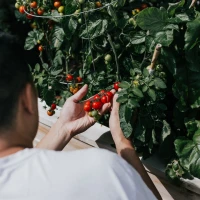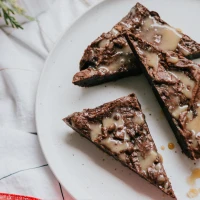Chicken. It’s the versatile core of countless dinner tables around the world. Yet, we don’t just love it for its ubiquity or its unassuming flavor; a well-cooked chicken dish can be a revelation. In particular, juicy split chicken breast cooked to perfection in the oven offers a canvas of culinary possibilities—especially when paired with the right vegetables. In this guide, we’ll dive deep into the art of cooking succulent split chicken breast in the oven and discerning the perfect vegetable accompaniments to elevate your meal to the heights of gastronomy.
Crafting a mouthwatering oven-roasted split chicken breast is simple, yet the nuances are many. And when you’re a veggie lover, whether by choice or by dietary necessity, finding the perfect pairings is key to a harmonious plate. Not only will we provide you with a step-by-step process of creating that ideal juicy chicken, but we’ll also offer a variety of vegetable pairings, tips, and tricks to ensure that your dish sings with flavor and nutrition. Let’s unleash your inner chef and transform your kitchen into a space where poultry meets garden in a symphony of taste.
The Basics of Baking Split Chicken Breast in the Oven
Before we explore the world of vegetables, let’s ensure we know how to create a juicy split chicken breast foundation. The secret lies in the preparation, seasoning, and cooking process.
Preparing Your Chicken For The Oven
- Bring to Room Temperature: Letting your chicken sit at room temperature for about 20 to 30 minutes can promote even cooking.
- Pat Dry: Use paper towels to pat the chicken dry to ensure that seasonings stick and to help the skin get crispy.
- Season Generously: Your chosen herbs and spices will create the profile of your meal. Salt, pepper, garlic powder, and a touch of paprika are classics, but feel free to experiment.
- Olive Oil or Butter: A light coating will help the skin become golden and crispy.
The Oven Roasting Process
- Preheat Your Oven: Consistent heat is crucial. Start by preheating your oven to 375°F (190°C).
- Roasting Rack: Using a rack in your baking pan allows heat to circulate around the chicken, cooking it evenly and allowing the skin to crisp up.
- Cooking Time: A general rule is to cook the chicken for 25 minutes per pound, or until the internal temperature reaches 165°F (74°C).
Ensure Juiciness and Avoid Common Mistakes
- Do Not Overcook: Overcooking is the nemesis of juiciness. Use a meat thermometer to check doneness.
- Rest After Cooking: Letting the chicken rest for 5-10 minutes after baking allows juices to redistribute.
The Art of Vegetable Pairing
When it comes to pairing veggies with your split chicken breast in oven, consider both harmonious flavors and textures. Vegetables can complement, contrast, or enhance the chicken’s natural flavors.
Matching Flavors
- Classic Combinations: Carrots, celery, and onion play well with chicken, giving a milder, savory flavor profile.
- Bright and Bold: Bell peppers or tomatoes can introduce a sweet and slightly tart element to the dish.
- Aromatic Allure: Garlic, shallots, and leeks add depth and a hint of sweetness when roasted.
Considering Textures
- Crunchy Contrast: Roasted broccoli or cauliflower provide a substantial bite alongside the tenderness of the chicken.
- Soft and Supple: Zucchini or eggplant can offer a softer, moisture-rich texture that contrasts with the chicken’s crisp skin.
Seasonal Selections
- Spring: Asparagus and peas bring freshness and a vibrant green to your plate.
- Summer: Corn, green beans, or cherry tomatoes add a pop of color and a sweet bite.
- Fall: Pumpkin, squash, or Brussels sprouts bring heartiness and earthy flavors.
- Winter: Root vegetables such as parsnips or sweet potatoes offer a comforting warmth and sweetness.
The Importance of Seasonings and Herbs
Whether used on the chicken or the vegetables, the right seasonings and herbs make all the difference. Consider using fresh herbs like thyme, rosemary, or parsley to infuse your dish with a garden-fresh aroma and complex tastes.
Herbaceous Harmony
- Thyme gives a subtly earthy flavor that pairs ecstasy with chicken and mushrooms.
- Rosemary’s piney fragrance is ideal for partnering with root vegetables.
- Parsley, with its light and fresh notes, can brighten up a dish of chicken and carrots.
Spice Things Up
Incorporating spices like turmeric, coriander, or smoked paprika can elicit bursts of flavor that bring your dish to life.
- Turmeric offers a warm, bitter flavor and a yellow hue that pairs splendidly with cauliflower.
- Coriander possesses a lemony citrus aroma that match with the sweetness of roasted carrots.
- Smoked Paprika brings complexity and a touch of heat, perfect for sweet potatoes.
Cooking Techniques to Enhance Flavor
Roasting Vegetables with Chicken
Roasting your vegetables in the same pan as your chicken can allow them to soak up the meaty juices, creating an unparalleled blend of flavors.
- Layer Flavors: Scatter onions, garlic, and herbs under the chicken to infuse every bite with herbaceous notes.
- Timing is Everything: Add vegetables that cook quickly, like asparagus or spinach, in the last few minutes of roasting to avoid mushiness.
Separate But Equal: Cooking Veggies apart from Chicken
If you prefer more control over the doneness of your vegetables or to keep flavors distinct, roast them separately.
- Season Individually: Tailor your seasonings to each vegetable to customize the flavor profile of your meal.
- High Heat for a Quick Finish: Vegetables like bell peppers or zucchini roast beautifully at higher temperatures for a short time to maintain their crispness.
Final Plating: Bringing It All Together
When it comes to presenting your meal, consider color, texture, and balance. A well-plated dish not only delights the eye but also the palate.
Visual Appeal
- Color Contrast: Pair green veggies like broccoli or Brussels sprouts against the golden brown of your chicken for a vivid display.
- Add a Garnish: A final sprinkle of freshly chopped parsley or a wedge of lemon can add a bright finishing touch.
Nutritional Balance
A variety of vegetables ensures a wide range of vitamins and minerals. Include leafy greens like kale or spinach for iron and root vegetables for beta carotene.
Flavor Fusion
Create a balance of flavors by pairing the natural richness of chicken with the freshness or acidity of vegetables like tomatoes or squashes.
Frequently Asked Questions about Oven-Roasted Chicken and Veggie Pairings
How do you keep chicken breast moist when roasting?
Ensure the chicken breast is not overcooked by using a meat thermometer. Cook to the recommended internal temperature and allow the meat to rest.
What are the healthiest vegetables to pair with chicken?
Leafy greens, cruciferous veggies like broccoli, and colorful peppers are among the healthiest choices that provide essential nutrients and fiber.
Can I cook frozen vegetables with my split chicken breast in the oven?
Yes, but for the best results, thaw and pat them dry to prevent excess moisture from affecting the cooking process.
What herbs go best with chicken and vegetables?
Herbs such as thyme, rosemary, and parsley are classic pairings for both chicken and a wide range of vegetables.
Conclusion: Celebrating the Union of Poultry and Garden
Embracing the art of juicy split chicken breast in oven cooked alongside a bounty of vegetables isn’t just a route to a satisfying meal; it’s a journey through flavors, textures, and colors that celebrate the natural affinity between land and earth. Harness these techniques, respect the ingredients, and you’ll be well on your way to creating deeply flavorful, balanced, and healthy meals that not only entice the senses but also nourish the body.
Remember that the key to a stellar chicken and vegetable dinner lies in the quality of your ingredients, precision in cooking, and the love you pour into every step—from the garden to the oven. Now go forth, culinary adventurer, and let your kitchen be the stage for yet another delicious revelation where succulent chicken meets the best of the vegetable world.










